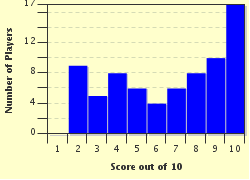Quiz Answer Key and Fun Facts
1. They called her 'Old Blue' and when the Wildlife Service found her in 1980, she was the only bird of her species left who could lay eggs. Now there are 200 birds, all descended from Old Blue. What type of bird was she?
2. This dark blue songbird bird with paler blue wattles and black mask is a forest dweller belonging to the family, Callaeidae, species cinereus and was almost certainly living and breeding in New Zealand hundreds of years before the first man set foot in the country. Its clear, pure notes ring out all day although breeding pairs will sing together in early morning. What's the name of this beautiful songbird?
3. Now regarded as a native bird, in spite of its name, this water-dweller is sooty black with a white patch on its forehead. They lay as many as 10 eggs, two broods a year quite often, in a raggedy nest of weeds and sticks. The chicks, though black, often have bright red head patches but these fade to white with maturity. Name this water bird.
4. A nocturnal bird, its Maori name is Ruru and regarded by many as of great spiritual significance. Its name comes from the words it appears to call. What is it?
5. This seemingly friendly little bird will dart about and follow you as you stroll through the bush but it is only waiting for your feet to disturb insects. What is it?
6. Zosterops lateralis, although not an indigenous bird, was first seen in New Zealand in 1832. It is now abundant all over the country and in many different habitats including, town gardens. This beautiful little green bird has a smoky grey back and a white ring around its eyes and forms flocks in winter to search for seasonal foods: fruits, invertebrates and nectars. Can you name it?
7. The name Anthornis melanura, gives no clue to the glorious song given by this bird. At dawn and dusk they delight all who hear them with trills, solos and even duets between male and female - and the song varies from region to region. M‚ori often compare a person's fine singing to this bird, as a compliment. At around 20cm long, they are olive, lemon, blue and black with a red eye. Can you name this favourite songbird?
8. This flightless bird is the heaviest parrot in the world at up to 4 kilos (8.8lbs) and can live between 60 and 100 years. To breed successfully, they need abundant food supplies, fruit especially but often their habitat does not supply this and coupled with their trusting nature towards predators, has led to their virtual extinction. Can you name this endangered parrot?
9. Mostly feeding on krill, this penguin, Pygoscelis antarctica, is confined to the Antarctic Peninsula, with a few breeding around the Ross Sea.
About 77 centimetres long, they are black and white, have white faces with a thin, black line running beneath the chin. Which penguin is it?
10. Their strange name is thought to come from the Dutch meaning "stupid gull" and
their reluctance to approach humans. They are rarely seen following ships like other albatrosses.
Black and white with a long, hooked-end yellow bill and feet, it has a 210-260cm (83-100 inches) wingspan. What seabird goes by this odd name?
Source: Author
Waitakere
This quiz was reviewed by FunTrivia editor
guitargoddess before going online.
Any errors found in FunTrivia content are routinely corrected through our feedback system.

